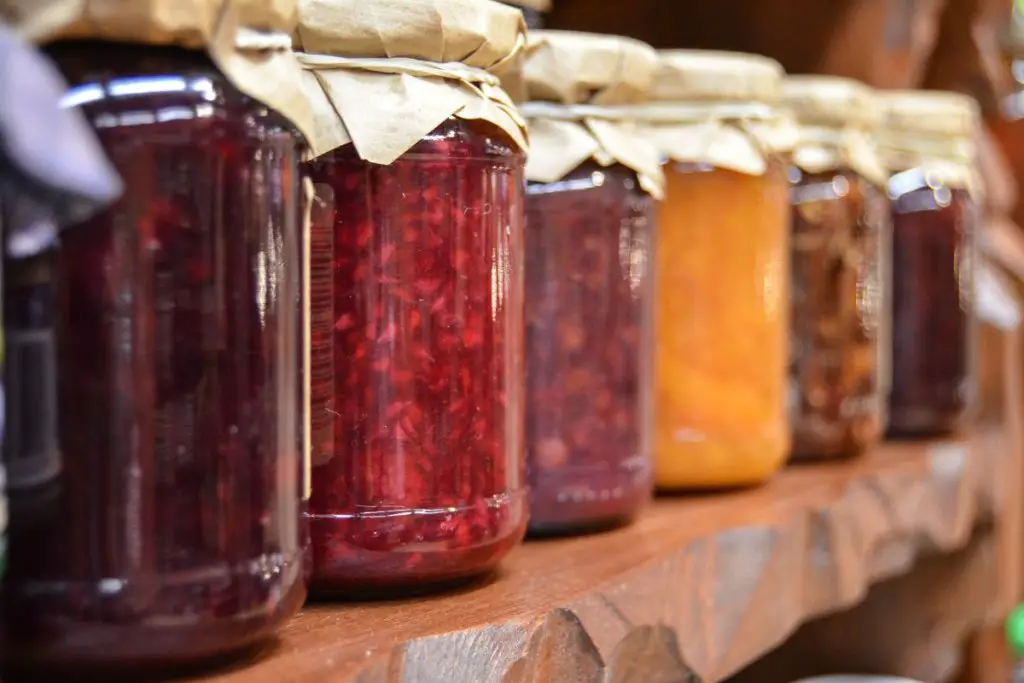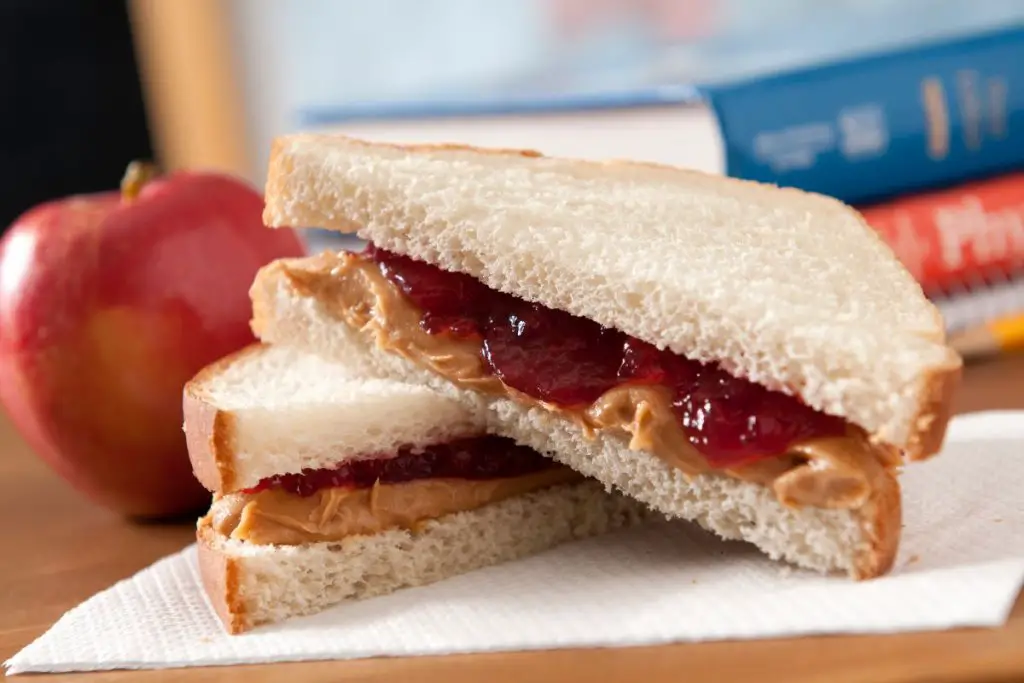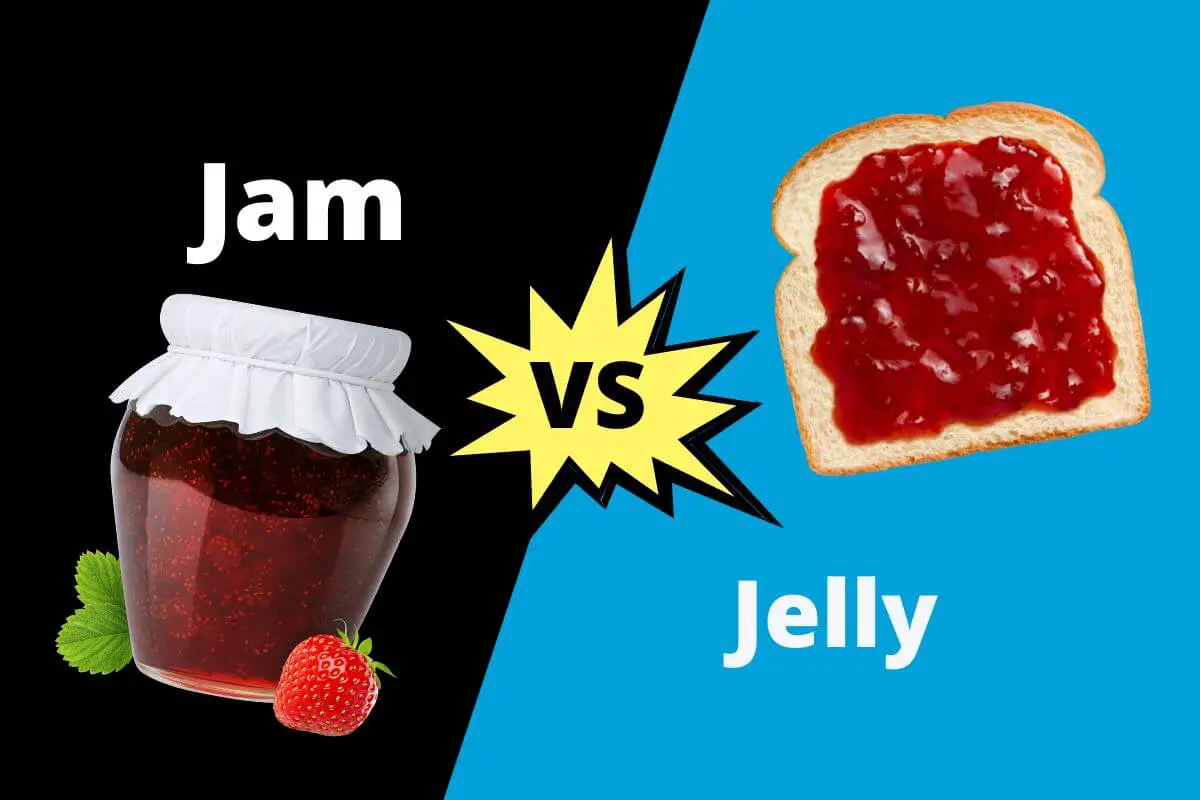The main difference between jam and jelly is that jam is made from mashed chunks of fruit, whereas jelly is made from strained fruit. Also, jam isn’t as spreadable as jelly.
Table of Contents
Jam vs Jelly
| Jam | vs | Jelly |
| Sugar, pectin, and mashed fruits | Ingredients Used | Pectin, sugar, and fruit juice |
| Syrup that has gelled and is unable to stay put | Physical Form | Clear and gleaming, it maintains its position |
| Pieces of mashed fruits | Ingredients Used | In the form of fruit juice |
What is Jam?
Jam is chopped or crushed fruit combined with gelatin and sugar and boiled until it thickens. It’s different from jelly because it’s made from fruit pulp, whereas jelly is solely made from the juice collected.
In jams, you’ll find large chunks of fruit as you spread it because jams are made from pressed and mashed large pieces of fruit.
Also, jam is much more comparable to preserves or conserves, which are also produced from fruit pulp.

How to Prepare Jam
You can turn any fruit into jam if you prepare it properly.
Follow these easy yet effective steps:
- Clean, trim, and cut into little chunks or pieces.
- Combine the fruit pieces, pectin, and sugar in a Dutch oven and stir well.
- Heat to a full boil, then reduce heat and simmer for 3 minutes.
- Fill sterilized jars halfway with the mixture and cover with lids.
- Cook for 10 minutes in a water bath.
- Remove the cans from the hot water bath canner and let them cool on a cloth.
What is Jelly?
Jelly is distinct from other pureed fruit because it does not include any genuine fruit fragments. The fruit’s juice or juices is the sole source of color and taste.
You can make jelly by heating, crushing, and filtering fruit to extract juice, then combining the liquid with sugar and gelatin and cooking to a solid consistency. When compared with jam, marmalade, and chunky peanut butter, jelly is the smoothest because it doesn’t contain chunks of fruit or pieces of fruit within it.

How Do You Make Jelly?
Making jelly is straightforward. All you have to do here is follow some simple steps:
- To make jelly, you can wash, peel, and pit the fruit of your choice, cut the pulp and boil it with sugar and pectin.
- Put the skins and seeds from the fruit you just prepared jelly from in a big saucepan and cook for around 30 minutes.
- Strain the juice, which you may combine with sugar and gelatin to produce a tasty jelly.
- You can use the same process to make jelly from different fruits.
Difference Between Jam and Jelly
Jam and jelly are two types of fruit spreads that are commonly paired with bread or scones. These two spreads differ in terms of the ingredients, the fruit’s physical form, and the preparation method.
Jelly is a transparent fruit spread produced with pectin and composed of freshened fruit juice. Jam comes from the entire fruit that has been chopped into bits or mashed. The fruit pulp is present in jams, whereas jellies contain fruit juice.
Production
Jam is made by boiling mashed or diced fruit pulp with sugar and water. The quantity of sugar and fruit depends significantly on the kind and freshness of the fruit. Still, an excellent place to start is the equivalent weights of both.
When the mixture hits 219 degrees Fahrenheit (104 degrees Celsius), the acid and gelatin in the fruit combine with the sugar, and the jam sets as it cools.
On the other hand, manufacturers make jelly by heating fruit juice and sugar with gelatin as a jelling ingredient and lemon juice as an acid to maintain the constant texture of the jelly.
Physical Form
Jam is a mushy pulp that doesn’t hold its shape. Jelly, however, is a more solid substance that keeps its form.
When properly set, excellent jelly is always transparent and sparkling. Jam, on the other hand, retains the dark color of the remaining fruit pulp.
Ingredients Used
Usually, jelly doesn’t contain fruit bits. Specialty jellies, such as pepper jelly, may contain fragments of jalapeno or other pepper.
Jams are made from chopped fruits or vegetable pulp. While the fruit element of jelly is juice, the fruit portion of jam is pulp.
Which Fruits Can’t Make Two Things Together?
Some fruits aren’t suitable for making two different items from the same batch. Figs and grapes are only good for one usage. What’s left of such fruits after you drain all the juice is unfit for anything other than composting.
You may make jam with the grapes by mixing it with sugar and pectin or preserve the figs by mixing them with sugar. Unfortunately, you won’t be able to do both.
Which Is Better: Jam or Jelly?
The best choice for a handmade fruit product would have to be a refrigerated jam prepared with sweet fruit with no extra additives.
Consuming is raw fruit is a healthy habit. It’s natural, despite its high sugar content. Fruit is also heavy in fiber and water, making it a satisfying snack. When you add sugar, gelatin, and other ingredients to fruit to jelly or jam, you lose a huge amount of the healthful advantages.
Is Marmalade Jam or Jelly?
Marmalade is a popular type of fruit spread in Great Britain that has roots in the Roman era. While marmalade is similar to both jam and jelly, it’s not considered to be either one. Marmalade is explicitly made from citrus fruits, and it uses the whole fruit. This includes mashed-up pieces of fruit, citrus peel, and the rind.
If you’ve found this article helpful, check out our post on soup versus stew.

